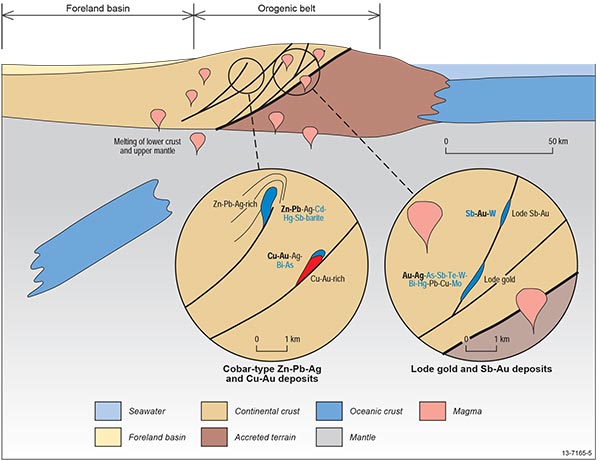Majestic Orogenic Mine has its origin from Sea Both lode gold and Cobar-type Cu-Au-Zn-Pb-Ag deposits, the two main deposit types in the orogenic mineral system, are associated with continental margin accretionary (oceanic-continental) and collisional (continent-continent) orogens. They typically occur in granite-greenstone terranes or in terranes dominated by turbiditic (meta-sedimentary) rocks, and are commonly associated with second- and third-order faults and shear zones (Vearncombe et al., 1989; Lawrie and Hinman, 1998). Temporally, the deposits commonly form during the late stages of orogenesis. Although present in rocks that are characterised by a large range in metamorphic grade (pumpellyite-prehnite to granulite facies), these deposits are most common in low to mid-greenschist facies rocks (Groves et al., 1998). This observation on lode gold deposits led Groves et al. (1998) to propose a crustal continuum model for lode gold deposits, in which metal assemblages change with depth, with Hg and Sb enriched in high level systems (a trend also present in the porphyry-epithermal mineral system). As Cobar-type deposits are much less common and less studied, variations in deposit characteristics with crustal depth have not been documented, although Zn-Pb-rich deposits seem to be slightly younger than Cu-Au-rich deposits in the Cobar district (cf., Champion et al., 2009).

Figure 2.7.1: Diagrammatic sketch of the orogenic mineral system illustrating the relative location of deposits types within the overall setting and the likely distribution of critical and other commodities within and around these deposit types. In the commodity lists, blue indicates critical commodities, underlined bold indicates major products, bold indicates commonly recovered by-products, underlined normal font indicates commodities with limited recovery as a by-product (usually during downstream processing), and normal text indicates commodities that are geochemically anomalous, but not recovered.
The relation between mineralisation in the orogenic mineral system and magmatism is fraught. In several major lode gold provinces, such as the Eastern Goldfields Superterrane and the Tanami province, there is a close temporal and, in some cases, spatial relationship between magmatism and mineralisation (Blewett et al., 2010; Huston et al., 2007), yet in other major gold events, such as the ˜440 Ma Benambran event in Victorian goldfields, magmatism has not been found to overlap gold mineralisation, despite extensive geochronologic studies of granites and lode gold deposits (Champion et al., 2009). In the Cobar Cu-Au-Zn-Pb-Ag district, magmatism is not known to overlap in time with mineralisation (e.g., van der Wielen and Glen, 2007; Champion et al., 2009).T